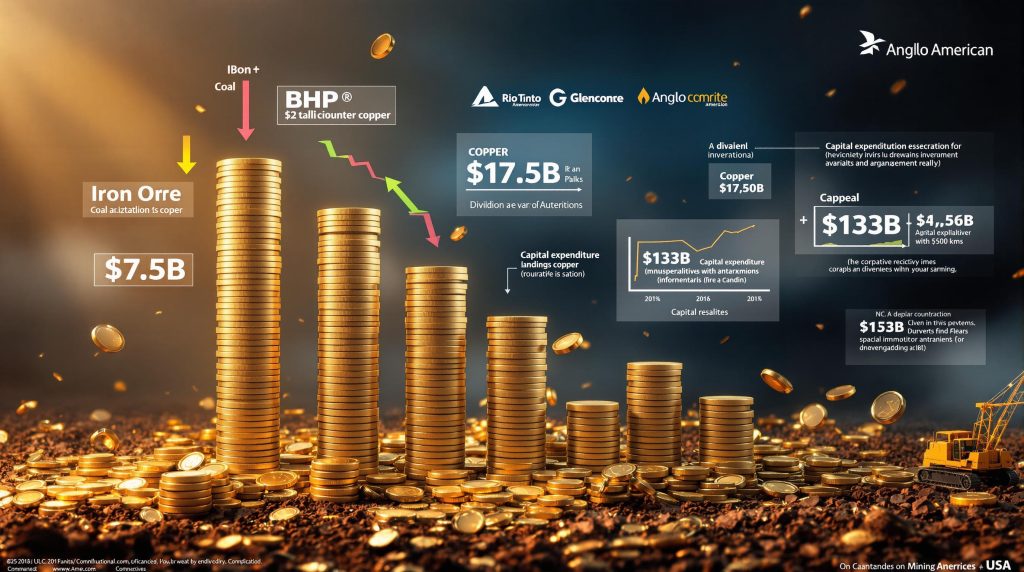Why Are Mining Giants Cutting Dividends in 2025?
The mining sector is witnessing a significant shift as major players scale back dividend payments amid challenging market conditions. This marks a stark contrast to the generous shareholder returns that characterized the industry in recent years. Major mining companies are prioritizing capital preservation and future investments over immediate shareholder rewards, signaling a fundamental change in their financial strategy.
Industry data shows a clear pattern of reduced payouts across the board, with several mining giants slash dividends amid falling commodity prices, with many announcing their lowest dividend levels in years. This cautious approach reflects broader economic uncertainties and specific industry challenges that have emerged in 2025.
What Factors Are Driving Dividend Reductions?
Commodity Price Declines
The most immediate driver behind dividend cuts is the significant drop in key commodity prices. Iron ore price trends have shown falls of approximately 13% since January 2025, directly impacting the revenue streams of major diversified miners. Coal has experienced a similar decline of around 13% during the same period, further pressuring profits.
Only copper has demonstrated resilience in this challenging environment, posting an 8% price increase in 2025. This strength is largely attributed to growing demand from the energy transition sector, but unfortunately, copper gains have not been sufficient to offset losses in other commodities for most diversified miners.
Massive Capital Expenditure Requirements
Mining companies are facing substantial investment requirements to maintain and expand their operations:
- BHP's Jansen potash project in Canada now requires up to $7.4 billion, a significant increase from the previous estimate of $5.7 billion
- Rio Tinto has announced plans to invest over $13 billion in iron ore mine development over the next three years
- These investments represent the most capital-intensive development phase the industry has seen in years
- Capital expenditure is increasingly directed toward maintaining production levels as existing mines mature
"The industry is entering a necessary but expensive phase of reinvestment," explains Brenton Saunders, portfolio manager at Pendal Group in Sydney. "Companies must allocate significant capital to replace depleting assets and develop new resources, which inevitably impacts funds available for dividends."
Weakened Financial Performance
The financial results tell a clear story of industry-wide pressure:
- Glencore recorded a 14% earnings decline due to weaker coal prices and reduced copper output
- Rio Tinto posted its smallest first-half profit since 2020, reflecting operational challenges and cost pressures
- Anglo American recorded a $1.9 billion loss amid ongoing restructuring efforts
- Production costs have increased across the sector due to inflationary pressures and declining ore grades
These financial headwinds make it increasingly difficult for mining companies to maintain their previous dividend levels while also funding necessary capital investments.
How Severe Are the Dividend Cuts?
Current Dividend Status by Company
The dividend reductions vary by company but reflect a consistent downward trend:
- Glencore maintained its dividend at $0.05 per share – the lowest since 2021
- Rio Tinto issued its lowest interim dividend in seven years
- Anglo American cut dividends to five-year lows
- BHP's projected full-year payout of $1.02 would represent an eight-year low
These figures represent significant reductions from peak levels and signal a more conservative approach to capital allocation across the industry.
Historical Comparison
The current dividend landscape contrasts dramatically with the recent past:
- During 2021-2022, mining companies distributed record dividends amid soaring commodity prices
- The pandemic and Russia-related supply disruptions previously supported higher commodity prices
- China's infrastructure spending drove exceptional demand for raw materials
- Current dividend levels represent a return to pre-boom payout ratios rather than an unprecedented decline
This historical perspective suggests the industry may be normalizing after an exceptional period rather than facing a fundamental crisis. However, the rapid decline in payouts has surprised many investors who had grown accustomed to generous returns.
What's Behind the Mining Industry's Changing Investment Landscape?
Transition from Cash Generation to Reinvestment
A fundamental shift is occurring in how mining companies approach their cash flow:
- The sector is pivoting from distributing profits to reinvesting in future growth
- Companies are prioritizing capital preservation for long-term sustainability
- Cash conservation has become a strategic imperative across the industry
- Balance sheet strength is being emphasized over immediate shareholder returns
This transition reflects the cyclical nature of mining and the need to prepare for future opportunities while managing current challenges. Companies are taking a longer-term view of value creation rather than maximizing short-term returns.
Focus on Future-Oriented Commodities
Strategic portfolio shifts are evident across the industry:
- Copper price prediction experts anticipate continued growth due to energy transition demand
- Critical minerals necessary for renewable technologies are receiving greater attention
- Traditional bulk commodities like coal are seeing reduced investment
- Battery metals and rare earth elements are becoming strategic priorities
However, these investments in future-oriented commodities remain too small to offset broader portfolio losses in the near term. The transition requires significant upfront capital with returns expected over a longer time horizon.
How Are Mining Companies Balancing Shareholder Returns and Growth?
Strategic Capital Allocation
Mining giants are implementing more disciplined approaches to capital allocation:
- Companies are carefully weighing dividend sustainability against investment needs
- Minimum dividend levels are being maintained while preserving capital for projects
- Progressive dividend policies are being reconsidered in light of market volatility
- Capital allocation frameworks now typically prioritize maintenance capital, followed by a minimum dividend, with growth projects and additional shareholder returns competing for remaining funds
This hierarchy of capital allocation represents a more conservative approach than seen during boom years when companies often increased dividends and pursued growth simultaneously.
Mine Replacement Imperatives
A key driver of capital expenditure is the need to replace depleting assets:
- Rio Tinto's investments aim to replace aging Western Australian operations that have been producing for decades
- BHP's potash project represents diversification beyond traditional mining assets to secure future revenue streams
- Anglo American's restructuring involves divesting underperforming assets to focus on core operations
- Geological challenges in aging mines require increasingly sophisticated and costly extraction methods
These investments are necessary for long-term business sustainability but come at the expense of near-term shareholder returns. Mining companies face the reality that high-grade, easily accessible deposits are increasingly scarce, requiring more capital to maintain production levels.
What's the Outlook for Mining Dividends?
Expert Perspectives
Industry analysts offer a cautious outlook for dividend recovery:
- Brenton Saunders of Pendal Group indicates dividends will likely remain subdued without commodity price recovery
- Analysts project continued pressure on payouts through 2025
- The sector may experience a structural shift in dividend expectations going forward
- Investors might need to adjust to a "new normal" of lower but more sustainable dividend levels
This outlook reflects both cyclical and structural changes affecting the mining industry, from commodity price volatility to increasing capital intensity of new projects.
Recovery Scenarios
Several factors could potentially improve the dividend outlook:
- Sustained commodity price improvements would directly boost available cash for distributions
- Chinese economic stimulus could drive mineral demand higher, particularly for construction materials
- Completion of major capital projects would free up cash for distributions
- Supply constraints in key commodities might eventually support price recovery through market rebalancing
While these positive scenarios are possible, they represent uncertain outcomes rather than guaranteed developments. Mining companies appear to be planning for continued challenging conditions rather than assuming rapid improvement.
How Should Investors Approach Mining Stocks in This Environment?
Adjusted Investment Strategies
Investors may need to reconsider their approach to mining investments:
- Focus on companies with diversified portfolios and strong balance sheets
- Consider miners with exposure to energy transition metals
- Evaluate capital allocation discipline and project execution capabilities
- Assess dividend policies for sustainability rather than yield alone
- Look beyond headline payout figures to understand the quality of underlying assets
These strategies emphasize fundamental analysis over yield-chasing, recognizing that the highest dividend today may not be sustainable if it comes at the expense of necessary reinvestment. Furthermore, understanding industry evolution trends is crucial for making informed investment decisions.
Long-term Value Proposition
Despite near-term dividend challenges, mining stocks may still offer compelling value:
- Current investments in mine development could yield future returns as projects come online
- Companies prioritizing operational efficiency may emerge stronger from this period
- Miners with lower production costs will maintain profitability despite price pressures
- Strategic positioning for future commodity cycles remains important for long-term investors
The mining sector's inherent cyclicality suggests that patient investors may be rewarded, particularly if they can identify companies making prudent investments for future growth while maintaining financial discipline. Evaluating investment opportunities insights can help investors navigate this complex landscape.
FAQ About Mining Dividends in 2025
How do mining dividends compare to other sectors currently?
Mining dividend yields have traditionally been higher than many sectors during commodity booms but are now converging with broader market averages. The sector's average dividend yield has declined from approximately 7-9% during peak periods to around 3-4% currently, bringing it closer to industrial and financial sector averages.
Will mining dividends return to previous highs?
A return to record dividend levels would require a significant recovery in commodity prices and completion of current capital-intensive projects. Analysts generally don't forecast this in the immediate term, suggesting investors should adjust expectations. The combination of maturing assets, increasing production costs, and capital requirements for new projects suggests the extremely high payout ratios of 2021-2022 may not be sustainable even with commodity price recovery.
Which mining companies are best positioned to maintain dividends?
Companies with diversified portfolios, lower debt levels, and exposure to energy transition metals like copper are generally better positioned to sustain dividend payments. Those with lower-cost operations and less immediate capital requirements for major projects may also maintain more stable dividends. Investors should evaluate companies based on their all-in sustaining costs, balance sheet strength, and pipeline of near-term projects requiring funding.
How are ESG considerations affecting mining dividends?
Environmental, social, and governance factors are increasing capital requirements as companies invest in sustainable operations. These investments include:
- Water management and conservation technologies
- Renewable energy infrastructure for mining operations
- Community development projects
- Tailings management improvements
- Carbon reduction initiatives
While these investments may reduce funds available for dividends in the near term, they potentially reduce long-term operational risks and support social license to operate, which has become increasingly valuable in securing project approvals and avoiding costly disruptions.
Mining companies face the dual challenge of maintaining competitive returns while meeting rising stakeholder expectations for responsible operations. This balancing act is becoming a defining feature of the industry's financial strategy and will likely influence dividend policies for years to come. In many cases, industry restructuring strategies are being implemented to adapt to these new market realities and maintain competitiveness in the global market.
Want to Spot the Next Major Mineral Discovery Before the Market?
Stay ahead of the investment curve with Discovery Alert's proprietary Discovery IQ model, which instantly notifies subscribers about significant ASX mineral discoveries as they happen. Visit our discoveries page to see how historic mineral finds have generated substantial returns and start your 30-day free trial today.




